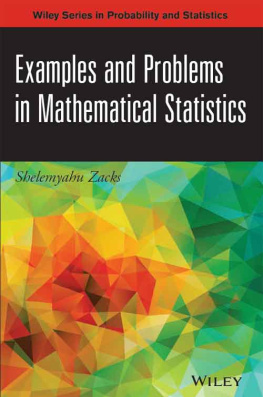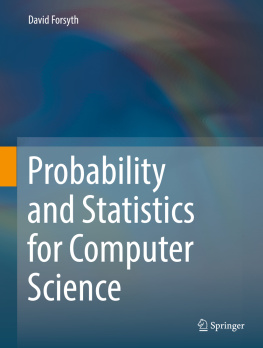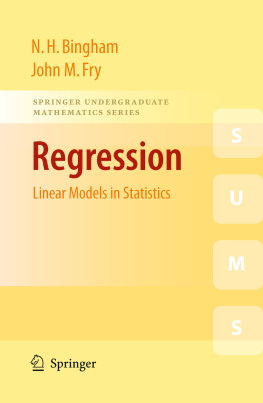SCHAUMS OUTLINE OF Theory and Problems of STATISTICS AND ECONOMETRICS
SECOND EDITION
DOMINICK SALVATORE, Ph.D.
Professor and Chairperson, Department of Economics, Fordham University
DERRICK REAGLE, Ph.D.
Assistant Professor of Economics, Fordham University

DOMINICK SALVATORE is Professor and Chairperson of the Department of Economics at Fordham University in New York City. He is the author of the textbook International Economics, 7th ed. (2001) and Managerial Economics in a Global Economy, 4th ed. (2001). He also authored the Schaums Outline Series in International Economics, 4th ed. (1996) and Microeconomic Theory, 3d ed. (1992) and coauthored, with Prof. Diulio, the Schaums Outline in Principles of Economics, 2d ed. (1996). His research has been published in numerous leading scholarly journals and presented at many national and international conferences.
DERRICK REAGLE is an Assistant Professor of Economics at Fordham University and a faculty member of Fordhams Graduate Program in International Political Economy and Development. He received his Ph.D. from Vanderbilt University in 1998. Since then, he has contributed significant scholarly research in the areas of statistical hypothesis testing, financial markets, and country risk analysis. Dr. Reagle has presented statistical and applied work at numerous conferences, published in academic journals, and advised the media on economic trends. Dr. Reagle has extensive experience teaching statistics, econometrics, and finance on both the undergraduate and graduate levels. Derrick Reagle currently resides in New York with is wife, Elizabeth, and two sons, Maxwell and Jackson.

Copyright 2002, 1982 by The McGraw-Hill Companies, Inc. All rights reserved. Except as permitted under the United States Copyright Act of 1976, no part of this publication may be reproduced or distributed in any form or by any means, or stored in a database or retrieval system, without the prior written permission of the publisher.
ISBN: 978-0-07-139568-7
MHID: 0-07-139568-7
The material in this eBook also appears in the print version of this title: ISBN: 978-0-07-134852-2, MHID: 0-07-134852-2.
All trademarks are trademarks of their respective owners. Rather than put a trademark symbol after every occurrence of a trademarked name, we use names in an editorial fashion only, and to the benefit of the trademark owner, with no intention of infringement of the trademark. Where such designations appear in this book, they have been printed with initial caps.
McGraw-Hill eBooks are available at special quantity discounts to use as premiums and sales promotions, or for use in corporate training programs. To contact a representative please e-mail us at bulksales@mcgraw-hill.com.
TERMS OF USE
This is a copyrighted work and The McGraw-Hill Companies, Inc. (McGraw-Hill) and its licensors reserve all rights in and to the work. Use of this work is subject to these terms. Except as permitted under the Copyright Act of 1976 and the right to store and retrieve one copy of the work, you may not decompile, disassemble, reverse engineer, reproduce, modify, create derivative works based upon, transmit, distribute, disseminate, sell, publish or sublicense the work or any part of it without McGraw-Hills prior consent. You may use the work for your own noncommercial and personal use; any other use of the work is strictly prohibited. Your right to use the work may be terminated if you fail to comply with these terms.
THE WORK IS PROVIDED AS IS. McGRAW-HILL AND ITS LICENSORS MAKE NO GUARANTEES OR WARRANTIES AS TO THE ACCURACY, ADEQUACY OR COMPLETENESS OF OR RESULTS TO BE OBTAINED FROM USING THE WORK, INCLUDING ANY INFORMATION THAT CAN BE ACCESSED THROUGH THE WORK VIA HYPERLINK OR OTHERWISE, AND EXPRESSLY DISCLAIM ANY WARRANTY, EXPRESS OR IMPLIED, INCLUDING BUT NOT LIMITED TO IMPLIED WARRANTIES OF MERCHANTABILITY OR FITNESS FOR A PARTICULAR PURPOSE. McGraw-Hill and its licensors do not warrant or guarantee that the functions contained in the work will meet your requirements or that its operation will be uninterrupted or error free. Neither McGraw-Hill nor its licensors shall be liable to you or anyone else for any inaccuracy, error or omission, regardless of cause, in the work or for any damages resulting therefrom. McGraw-Hill has no responsibility for the content of any information accessed through the work. Under no circumstances shall McGraw-Hill and/or its licensors be liable for any indirect, incidental, special, punitive, consequential or similar damages that result from the use of or inability to use the work, even if any of them has been advised of the possibility of such damages. This limitation of liability shall apply to any claim or cause whatsoever whether such claim or cause arises in contract, tort or otherwise.
CONTENTS
PREFACE
This book presents a clear and concise introduction to statistics and econometrics. A course in statistics or econometrics is often one of the most useful but also one of the most difficult of the required courses in colleges and universities. The purpose of this book is to help overcome this difficulty by using a problem-solving approach.
Each chapter begins with a statement of theory, principles, or background information, fully illustrated with examples. This is followed by numerous theoretical and practical problems with detailed, step-by-step solutions. While primarily intended as a supplement to all current standard textbooks of statistics and/or econometrics, the book can also be used as an independent text, as well as to supplement class lectures.
The book is aimed at college students in economics, business administration, and the social sciences taking a one-semester or a one-year course in statistics and/or econometrics. It also provides a very useful source of reference for M.A. and M.B.A. students and for all those who use (or would like to use) statistics and econometrics in their work. No prior statistical background is assumed.
The book is completely self-contained in that it covers the statistics (), a field of econometrics which has expanded as of late. A sample statistics and econometrics examination is also included.
The methodology of this book and much of its content has been tested in undergraduate and graduate classes in statistics and econometrics at Fordham University. Students found the approach and content of the book extremely useful and made many valuable suggestions for improvement. We have also received very useful advice from Professors Mary Beth Combs, Edward Dowling, and Damodar Gujarati. The following students carefully read through the entire manuscript and made many useful comments: Luca Bonardi, Kevin Coughlin, Sean Hennessy, and James Santangelo. To all of them we are deeply grateful. We owe a great intellectual debt to our former professors of statistics and econometrics: J. S. Butler, Jack Johnston, Lawrence Klein, and Bernard Okun.
We are indebted to the Literary Executor of the late Sir Ronald A. Fisher, F. R. S., to Dr. Frank Yates, F. R. S., and the Longman Group Ltd., London, for permission to adapt and reprint Tables III and IV from their book, Statistical Tables for Biological, Agricultural and Medical Research.
In addition to Statistics and Econometrics, the Schaums Outline Series in Economics includes Microeconomic Theory, Macroeconomic Theory, International Economics, Mathematics for Economists










